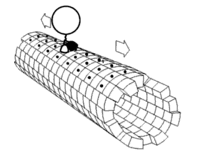Multiprotein complex

Have you ever played with blocks? Imagine you have a bunch of different shapes, like squares, triangles, and circles. Now, imagine you want to build a tower with these blocks. To make the tower sturdy and strong, you need to stack the blocks in a specific way, so they fit together perfectly.
In our bodies, cells have to build structures too, like tiny machines that help keep everything working properly. These structures are made up of tiny building blocks called proteins. But just like with building blocks, one protein isn’t always enough to build a complex structure. Sometimes, cells need to put several proteins together to create something that’s strong and functional—a multiprotein complex!
Think of each protein in a multiprotein complex like a different building block. Each protein has a specific role to play in the structure, just like each block has a specific shape in your tower. When cells need to build a complex structure, they enlist a bunch of different proteins to work together.
Now, imagine you have a bunch of people working together to build something, like a treehouse. Each person has a specific job to do, like hammering nails, sawing wood, or holding boards in place. They need to communicate effectively and work together to make sure everything fits together perfectly.
In the same way, proteins in a multiprotein complex need to communicate and work together to make sure the structure is built correctly. They interact with each other in specific ways, like puzzle pieces fitting together perfectly. As they work together, they create a strong, functional structure that can do important things, like help cells communicate or break down waste.
So, in summary, a multiprotein complex is like a tower or treehouse built with different shaped building blocks or different people working together. Proteins in a multiprotein complex have specific roles to play, and they work together to create strong, functional structures in our cells.
In our bodies, cells have to build structures too, like tiny machines that help keep everything working properly. These structures are made up of tiny building blocks called proteins. But just like with building blocks, one protein isn’t always enough to build a complex structure. Sometimes, cells need to put several proteins together to create something that’s strong and functional—a multiprotein complex!
Think of each protein in a multiprotein complex like a different building block. Each protein has a specific role to play in the structure, just like each block has a specific shape in your tower. When cells need to build a complex structure, they enlist a bunch of different proteins to work together.
Now, imagine you have a bunch of people working together to build something, like a treehouse. Each person has a specific job to do, like hammering nails, sawing wood, or holding boards in place. They need to communicate effectively and work together to make sure everything fits together perfectly.
In the same way, proteins in a multiprotein complex need to communicate and work together to make sure the structure is built correctly. They interact with each other in specific ways, like puzzle pieces fitting together perfectly. As they work together, they create a strong, functional structure that can do important things, like help cells communicate or break down waste.
So, in summary, a multiprotein complex is like a tower or treehouse built with different shaped building blocks or different people working together. Proteins in a multiprotein complex have specific roles to play, and they work together to create strong, functional structures in our cells.
Related topics others have asked about:
